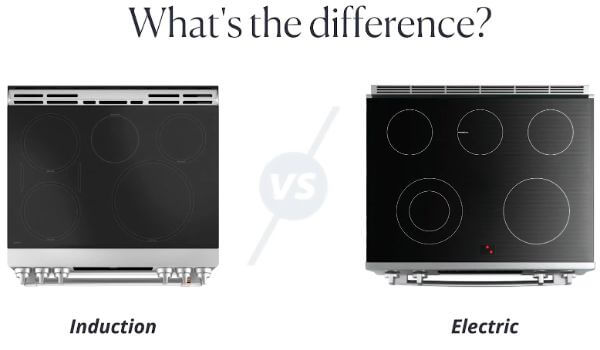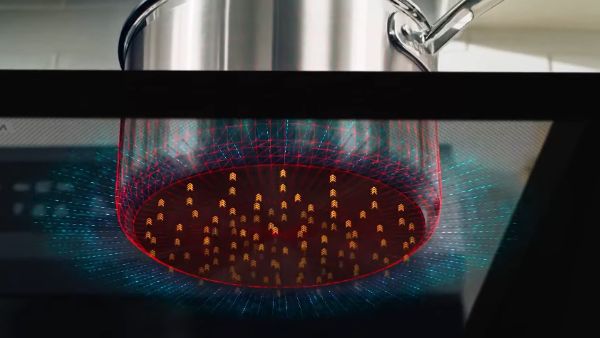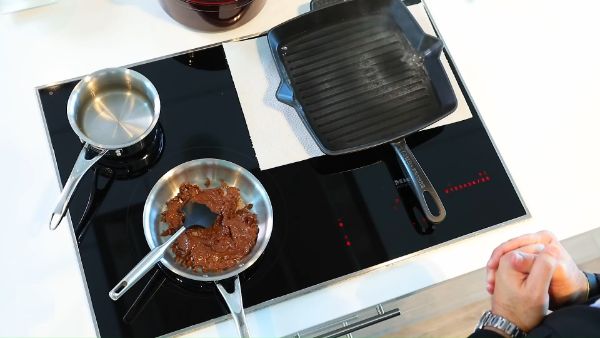If induction cooking were easier to explain, we’d all already be using it three times a day. It’s great—it’s just got a name problem.
Table of Contents
What is Induction Cooking?
I’m going to explain things induction is and things it is not.
In this article, I’m going to bust some myths about induction, starting with how it’s not the same as a slow electric cooktop.
I’ll also explain the true advantages we think make it a smart, safe, and satisfying choice. In the end, you’ll have a clearer understanding of how it works and all its pros and cons for cooking.
You’ll also have a sense whether it’s something you want in your kitchen.
Induction vs Electric
For starters, while it’s still powered by electricity, induction is very different from an old-school electric coil or radiant heat cooktop.
It’s no wonder people mix them up, though—they look the same.
We hear all the time from people who’ve bought a new house or apartment and think their new cooktop isn’t working because it’s not getting hot.
But if it’s induction, it’s not broken—it’s just not heating up the way they’re used to.
Why?
Under the surface, modern cooktops have radiant coils that give off heat when electricity runs through them.
Induction cooktops have copper coils underneath that emit an electromagnetic current when electricity runs through them. They transfer that energy directly to your pan without actually heating up.
The pan is the only thing that gets hot—not the coils or the cooktop.
Why Induction is Good For Cooking?
That’s why induction is great for cooking. It means less heat gets lost in the air around your pan, so the pan and what’s inside it heat up faster than with electric or gas.
You get much more responsive cooking power with induction. It boils water twice as fast as electric or gas.
And when you reduce the temperature, the heat goes down as quickly as gas – you get the same immediate feedback. You don’t have to wait for the heat to dissipate, like with electric.
That’s one of the biggest reasons we hear for people, including chefs, switching to induction.
An induction cooktop also heats up more evenly and consistently—you’re not “chasing a flame” the way you do with gas. That can be more annoying than you might think.
If you’ve got a window open or a ceiling fan on, the breeze can interfere with a gas burner. Shopping for a beach house? Induction might be the perfect choice.
Is Induction Cooking Safe?
That’s also why it is safer than electric or gas. Nothing gets hot except the pot. It is not going to get your kitchen hot either – another pro for summer cooking.
Induction is not safe for people who have pacemakers or other implanted cardiac devices, since the electromagnetic current can interfere.
Pots and Pans For Induction Cooktop
Let’s get into everybody’s biggest question – what cookware do you need for induction?
Induction is compatible with lots of pots and pans. They just need to have high iron content and a flat bottom that connects evenly with the induction heating element.
Enameled cast iron tends to work well.
Not sure if your pan will work? Try the magnet test.
If a magnet sticks to the bottom, you’re good to go.
If you try out a pan on an induction cooktop and it makes a lot of noise, it’s because it’s made of a mix of metals with less iron than is ideal. It’s not your cooktop—just try a different pan.
And here’s another pro tip: Avoid using raw cast iron or be really careful with it, since it can scratch the surface.
Induction is handy for oversize pots and pans. Most induction cooktops have burner-like heat elements, and some can “bridge” the space between two elements, firing up the space between them.
Others automatically sense where your pan’s sitting and send heat to it, wherever it touches the surface.
That means when you use something like a griddle, there’s no cold spot between burners; it’s evenly hot.
How to Clean Induction Cooktop
An induction cooktop is easy to clean—even easier than electric.
With gas, you have to clean the grates and burner pans. With electric, spillovers can scorch onto the glass.
With induction, you just wipe up messes – nothing burned on.
How Much Does Induction Cost?
It is not always expensive. High-end induction ranges from brands like La Cornue can be as pricey as you want, depending on how you customize them, but picks from brands like Frigidaire start at around $1300.
Finally, it is ideal for people who are into smart home technology. Induction stoves and cooktops tend to have more advanced features than gas or electric.
Most of them have touchscreen controls that operate like a smart phone.
That is not convenient when your hands are greasy or oily, though. Instead of being able to turn a knob, you have to wipe off your hands till your fingertips register.
It is not shatterproof. If you’re cooking with enameled cast iron and drop your pan, it can break.



